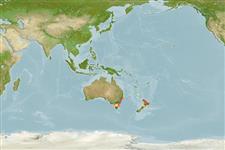Common names from other countries
Environment: milieu / climate zone / depth range / distribution range
Ecologia
marinhas associadas(os) a recifes; intervalo de profundidade 6 - 100 m. Subtropical; 25°S - 48°S, 140°E - 178°W
Southwest Pacific: southeastern Australia (New South Wales, Victoria, and Tasmania) and northeastern New Zealand.
Tamanho / Peso / Idade
Maturity: Lm ? range ? - ? cm
Max length : 11.7 cm SL macho/indeterminado; (Ref. 530); 8.6 cm SL (female)
Descrição suscinta
Morfologia | Morfometria
Espinhos dorsais (total): 9; Raios dorsais (total): 11; Espinhos anais 3; Raios anais : 10; Vértebras: 25. Initial phase color: body red-orange above, paler posteriorly; with a white-bordered black ocellus at the base of the 9th and 10th dorsal rays. Terminal phase color: body deep crimson, paler below; pearly white stripe running from corner of mouth to caudal fin base; head with six bright blue lines. Predorsal scales 4 (3-5). Cheek scale 1 row behind the eye; 2 rows below eye. No scaly sheath at the base of dorsal and anal fins. Scales large. Pectoral fin with two rudimentary dorsalmost rays.
Occurs in sand patches adjacent to reef areas in shallow waters. The species is a facultative cleaner symbiont, removing parasites and damaged scales and skin from other fishes; also feeds on small crustaceans from the bottom and from seaweed fronds.
Ciclo de vida ou comportamento de acasalamento
Maturidade | Reprodução | Desova | Ovos | Fecundidade | Larvas
Oviparous, distinct pairing during breeding (Ref. 205).
Russell, B.C., 1985. Revision of the Indo-Pacific labrid fish genus Suezichthys, with descriptions of four new species. Indo-Pac. Fish. (2):21 p. (Ref. 530)
Status na Lista Vermelha da UICN (Ref. 130435)
CITES (Ref. 128078)
Not Evaluated
Ameaça para os humanos
Harmless
Uso pelos humanos
Mais informação
Idade/TamanhoCrescimentoPeso-comprimentoComprimento-comprimentoFrequências de comprimentoMorfometriaMorfologiaLarvasDinâmica larvalRecrutamentoAbundância
ReferênciasAquaculturaPerfil para aquaculturaEstirpesGenéticaElectrophoresesHereditariedadeDoençasProcessamentoConversão de massa
ColaboradoresFotosStamps, Coins Misc.SonsCiguateraVelocidadeTipo de nataçãoÁrea branquialOtólitosCérebrosVisão
Ferramentas
Relatórios especiais
Baixar XML
Fontes da internet
Estimates based on models
Preferred temperature (Ref.
115969): 14.2 - 21.5, mean 15.8 (based on 122 cells).
Índice de diversidade filogenética (Ref.
82804): PD
50 = 0.5002 [Uniqueness, from 0.5 = low to 2.0 = high].
Bayesian length-weight: a=0.00501 (0.00207 - 0.01214), b=3.15 (2.94 - 3.36), in cm Total Length, based on LWR estimates for this (Sub)family-body shape (Ref.
93245).
Nível Trófico (Ref.
69278): 3.5 ±0.50 se; based on food items.
Resiliência (Ref.
120179): Elevada, tempo mínimo de duplicação da população menor que 15 meses (Preliminary K or Fecundity.).
Fishing Vulnerability (Ref.
59153): Low vulnerability (10 of 100).
